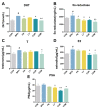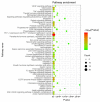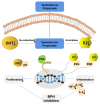Combination of Lycopene and Curcumin Synergistically Alleviates Testosterone-Propionate-Induced Benign Prostatic Hyperplasia in Sprague Dawley Rats via Modulating Inflammation and Proliferation
- PMID: 37446563
- PMCID: PMC10343798
- DOI: 10.3390/molecules28134900
Combination of Lycopene and Curcumin Synergistically Alleviates Testosterone-Propionate-Induced Benign Prostatic Hyperplasia in Sprague Dawley Rats via Modulating Inflammation and Proliferation
Abstract
Background: Benign prostatic hyperplasia (BPH) is a progressive urological disease occurring in middle-aged and elderly men, which can be characterized by the non-malignant overgrowth of stromal and epithelial cells in the transition zone of the prostate. Previous studies have demonstrated that lycopene can inhibit proliferation, while curcumin can strongly inhibit inflammation. This study aims to determine the inhibitory effect of the combination of lycopene and curcumin on BPH.
Method: To induce BPH models in vitro and in vivo, the BPH-1 cell line and Sprague Dawley (SD) rats were used, respectively. Rats were divided into six groups and treated daily with a vehicle, lycopene (12.5 mg/kg), curcumin (2.4 mg/kg), a combination of lycopene and curcumin (12.5 mg/kg + 2.4 mg/kg) or finasteride (5 mg/kg). Histologic sections were examined via hematoxylin and eosin (H&E) staining and immunohistochemistry. Hormone and inflammatory indicators were detected via ELISA. Network pharmacology analysis was used to fully predict the therapeutic mechanism of the combination of lycopene and curcumin on BPH.
Results: Combination treatment significantly attenuated prostate hyperplasia, alleviated BPH pathological features and decreased the expression of Ki-67 in rats. The upregulation of the expression of testosterone, dihydrotestosterone (DHT), 5α-reductase, estradiol (E2) and prostate-specific antigen (PSA) in BPH rats was significantly blocked by the combination treatment. The expression levels of inflammatory factors including interleukin (IL)-1β, IL-6 and tumor necrosis factor (TNF)-α were strongly inhibited by the combination treatment. From the network pharmacology analysis, it was found that the main targets for inhibiting BPH are AKT1, TNF, EGFR, STAT3 and PTGS2, which are enriched in pathways in cancer.
Conclusion: The lycopene and curcumin combination is a potential and more effective agent to prevent or treat BPH.
Keywords: BPH; curcumin; inflammation; lycopene; synergistic effect.
Conflict of interest statement
The authors declare that they have no competing interests.
Figures










Similar articles
-
Protective effects of combination of Stauntonia hexaphylla and Cornus officinalis on testosterone-induced benign prostatic hyperplasia through inhibition of 5α- reductase type 2 and induced cell apoptosis.PLoS One. 2020 Aug 13;15(8):e0236879. doi: 10.1371/journal.pone.0236879. eCollection 2020. PLoS One. 2020. PMID: 32790676 Free PMC article.
-
Asteris Radix et Rhizoma suppresses testosterone-induced benign prostatic hyperplasia in rats by regulating apoptosis and inflammation.J Ethnopharmacol. 2020 Jun 12;255:112779. doi: 10.1016/j.jep.2020.112779. Epub 2020 Mar 21. J Ethnopharmacol. 2020. PMID: 32209388
-
Kolaviron modulates angiogenesis, apoptosis and inflammatory signaling in rat model of testosterone propionate-induced benign prostate hyperplasia.Inflammopharmacology. 2023 Aug;31(4):2121-2131. doi: 10.1007/s10787-023-01171-7. Epub 2023 Mar 7. Inflammopharmacology. 2023. PMID: 36881348
-
Dihydrotestosterone and the concept of 5alpha-reductase inhibition in human benign prostatic hyperplasia.World J Urol. 2002 Apr;19(6):413-25. doi: 10.1007/s00345-002-0248-5. World J Urol. 2002. PMID: 12022710 Review.
-
Mechanism of Androgen-Independent Stromal Proliferation in Benign Prostatic Hyperplasia.Int J Mol Sci. 2023 Jul 19;24(14):11634. doi: 10.3390/ijms241411634. Int J Mol Sci. 2023. PMID: 37511400 Free PMC article. Review.
Cited by
-
Functional Food Nutrients, Redox Resilience Signaling and Neurosteroids for Brain Health.Int J Mol Sci. 2024 Nov 12;25(22):12155. doi: 10.3390/ijms252212155. Int J Mol Sci. 2024. PMID: 39596221 Free PMC article. Review.
-
Exploring the potential mechanism of Xiaojin Pill therapy for benign prostatic hyperplasia through metabolomics and gut microbiota analysis.Front Microbiol. 2024 Aug 21;15:1431954. doi: 10.3389/fmicb.2024.1431954. eCollection 2024. Front Microbiol. 2024. PMID: 39234552 Free PMC article.
-
Green chemistry for prostate health: exploring nature's toolbox against cancer, inflammation, and hyperplasia.Mol Divers. 2025 Aug 5. doi: 10.1007/s11030-025-11305-4. Online ahead of print. Mol Divers. 2025. PMID: 40762933 Review.
-
Association between serum carotenoids levels and severe headache or migraine in adults: a cross-sectional study from NHANES.Front Nutr. 2025 Jan 6;11:1507503. doi: 10.3389/fnut.2024.1507503. eCollection 2024. Front Nutr. 2025. PMID: 39834456 Free PMC article.
-
P. gingivalis in oral-prostate axis exacerbates benign prostatic hyperplasia via IL-6/IL-6R pathway.Mil Med Res. 2024 May 20;11(1):30. doi: 10.1186/s40779-024-00533-8. Mil Med Res. 2024. PMID: 38764065 Free PMC article.
References
-
- El-Sherbiny M., El-Shafey M., El-Agawy M.S.E.-d., Mohamed A.S., Eisa N.H., Elsherbiny N.M. Diacerein ameliorates testosterone-induced benign prostatic hyperplasia in rats: Effect on oxidative stress, inflammation and apoptosis. Int. Immunopharmacol. 2021;100:108082. doi: 10.1016/j.intimp.2021.108082. - DOI - PubMed
-
- Zhang W., Cao G., Sun Y., Wu F., Wang Q., Xu T., Hu H., Xu K. Depressive symptoms in individuals diagnosed with lower urinary tract symptoms suggestive of benign prostatic hyperplasia (LUTS/BPH) in middle-aged and older Chinese individuals: Results from the China Health and Retirement Longitudinal Study. J. Affect. Disord. 2022;296:660–666. doi: 10.1016/j.jad.2021.09.045. - DOI - PubMed
-
- Rachael N., Dianna M.E.B. Patient-Friendly Summary of the ACR Appropriateness Criteria: Lower Urinary Tract Symptoms-Suspicion of Benign Prostatic Hyperplasia. J. Am. Coll. Radiol. 2022;19:e9. - PubMed
-
- Abdel-Aziz A.M., El-Tahawy N.F.G., Abdel haleem M.A.S., Mohammed M.M., Ali A.I., Ibrahim Y.F. Amelioration of testosterone-induced benign prostatic hyperplasia using febuxostat in rats: The role of VEGF/TGFβ and iNOS/COX-2. Eur. J. Pharmacol. 2020;889:173631. doi: 10.1016/j.ejphar.2020.173631. - DOI - PubMed
MeSH terms
Substances
Grants and funding
LinkOut - more resources
Full Text Sources
Medical
Research Materials
Miscellaneous

